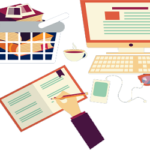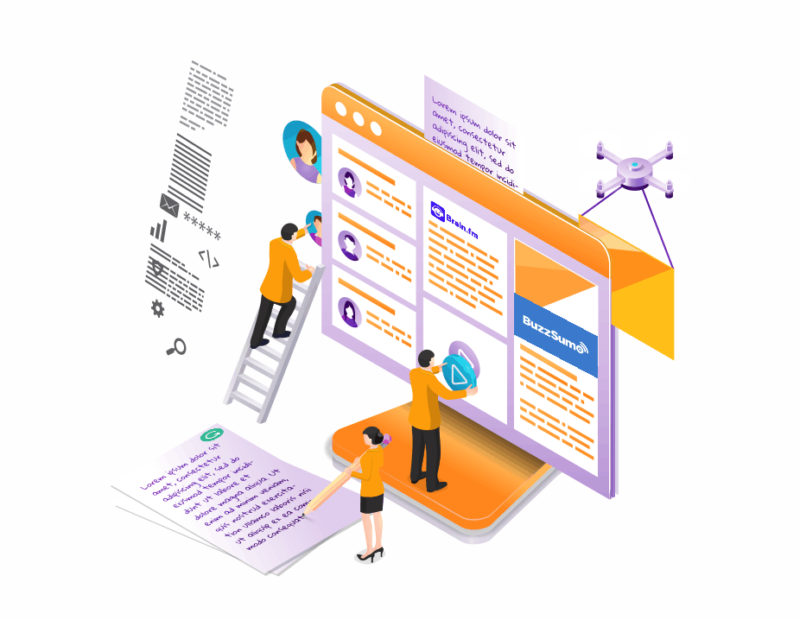content writingDigital Marketing
What is Email Content writing?
Every email is a clean canvas, full of possibility as well as potential. It is entirely up whether you will to seize or pass up this opportunity. Suppose you want to create the better email content writing. In that case, you’ll need to have a strategic plan, an understanding of social cognition, and the willingness to experiment until you discover the formula that works.
You don’t have to build from zero, though.Understanding best practices for email marketing can put you ahead of the competition even before you send your first email.
Make sure that even the slightest mistake can result in your prospects unsubscribing from your mailing list. Worse, if you are perceived as too spammy, users may blocklist your email address, resulting in all of your emails ending up in spam boxes.
Email content writing would be any message sent to a subscriber’s, customer’s, or prospect’s inbox, whether by hand or through the use of a comprehensive email builder or automation platform.
The email’s content includes- Everything from fortnightly to monthly newsletters to automated responses to promotions and new upcoming products is possible.
Email marketing encompasses any email sent to a customer or prospect during the customer lifecycle that provides value.
The length of your message in email writing will differ considerably depending on if you’re sending an automated response or a newsletter, as well as the level of design.
Email writing for products has emerged as one of the most popular forms of marketing available. It is effective, but it is also subjective and accessible to a wide range of businesses.
With all of this in mind, it’s easy to see why email marketing has such a special place in today’s content marketing and why so many persons want to learn how to write content for email marketing.
Email content ideas can be one of the most challenging aspects of developing a successful email marketing strategy for your company or organization.
Paying very close attention to what your audience is interested in is one of the best ways to generate content ideas. They are the people who will be receiving your emails, so it stands to reason that you should include content that is pertinent to them.
Types of Email Content writing
We have compiled a list of different types of email content writing to help you refresh your email strategy. While this list is not exhaustive, it is chock-full of innovative ideas that you can implement immediately.
- Welcome email or series of emails
- For a good reason, the welcome email has become a widespread practice for most organizations.
- This sort of email content writing has the most significant amount of openness and engagement.
- Clients and new subscriptions nowadays presume to see this type of email in their inbox after attempting to make their first purchase or subscription.
- Exceed their expectations by sending a fantastic welcome email or series of emails.
- Promotional Emails
- As consumers are becoming more cautious of this type of email content writing services, the world of promotional emails is changing.
- The world’s technology and information continue to advance, and consumers become more conscious of when messages are overly promotional.
- The challenge then becomes to provide a good mix of engaging emails (how-to content, informational content, and so on) and promotions.
- One way to do this is to incorporate content into your advertisements. Make your promotional emails concentrate on the sell or offer, emphasizing this focus with a prominent CTA.
- Then, perhaps beneath the introductory offer, you could provide additional free content that complements the proposal, albeit with a less eye-catching CTA.
- This allows customers to plunge their toes in without committing to a purchase, which may give you more opportunities to convert them later on.
- Guides, blogs, and other content marketing
- In an email, highlight your great content. If inbound or content marketing is one of your strategies, rest assured your list is aware of it!
- We use what we call “blog solos” at Campaign Monitor to highlight individual blog posts. We don’t expect readers to spend their entire day browsing our resource pages.
- Meanwhile, we know that many people want to be provided with curated and relevant content in an easy-to-access format.
- So we send emails with a summary of a blog post, followed by a solid call to action that entices them to read the rest.
- Loyalty and remuneration
- Loyalty and rewards can be expressed in a variety of ways, mainly when automation is used.
- Sending out rewards based on purchases is a good place to start. Attaining certain tiers of rewards is a great incentive that your email subscribers look for.
- Another idea for tech-related businesses is to send loyalty emails based on which parts of your app or service were used.
- If you have specific workflows that you want your customers to complete, you can send them an email congratulating them and rewarding them for their hard work (like a discount on an upgraded plan, for example).
Product/company announcements and newsletters
- A standard newsletter is critical, mainly if you are focusing on Email Content writing. Above all, these emails should be a consistent point of contact with your viewer.
- If they serve one purpose, it is to keep your up with the evolution of your audience’s minds and to remind them of your brand whenever possible.
- Any additional sales and engagement are a big plus, and you should undoubtedly optimize these campaigns to increase engagement.
- But make sure you’re sending something interesting to keep your readers’ attention.
Tips for Email writing
Here are some pointers and tricks for creating compelling and meaningful email content :
- Understand and write for your intended audience.
- You don’t communicate with parents the same way you talk to your children. Similarly, you wouldn’t converse with someone you’ve just met in the same way you would with someone you’ve known for years.
- You should approach your emails in the same manner.
- Based on what you do and how you do it, you probably already know a thing or two about your target customer.
- To understand more about your intended audience, you can conduct research and, with the help of email writers, write such types of emails that convince them.
2. Use simple, actionable language.
- Don’t play with your audience’s time.
- To make your point, use simple, actionable language.
- You can also include some trigger words to pique their interest.
3. Align your subject line and body copy.
- Your email’s subject line is its promise. It informs the recipient of what to expect inside the email.
- If your audience reads the email and felt abandoned by the subject line, they are unlikely to open another email from you. That is why the email writer’s subject line and body copy must be consistent.
- It’s enticing to use an overly dramatic subject line lifted from a Buzzfeed headline but resist the temptation. Or, at the very least, use that technique sparingly. If you are honest and transparent with your readers, you will gain their trust and loyalty.
- Of course, this doesn’t mean you can’t spice up your subject lines to catch people’s attention.
4. Make each email unique.
- Email clients that support personalization trinkets can be your most valuable asset in email marketing.
- A personalization token transforms a generic word or phrase into one that is tailored to the recipient.
- As long as the name is correct, most people would prefer the latter.
- Other personalization tokens can be used to increase intimacy and belief between you and your readers.
- You could, for example, include the recipient’s address or the name of their company. Just be careful not to overdo it.
- You don’t want to go from being an astute email marketer to a potential stalker.
5. Clarity should be prioritized.
- Everyone wishes they could write catchy prose. It is impossible to overestimate the value of clarity.
- If your viewers don’t understand why you’re sending them an email, they’ll hit the “delete” button and start moving on. Don’t squander your time on clever puns and witty witticisms.
- Once you’ve decided on a goal for the email, make sure every sentence, image, and link contributes to that goal. Allow yourself to veer off-topic, even if you have something amusing or entertaining to share.
- You can end up making your copy as catchy as you want as long as it is relevant to the purpose of the email.
Conclusion
- If you’ve been looking for a way to connect with your audience on a more detailed, personal level, email content writing could be the answer.
- Don’t let your Email Content writing go out of date! Keep in mind to pull reports now and then track as you experiment as you consider applying some of these types of email content to your strategy.
- See what resonates with your intended audience, try to maximize your impact based on what they want to see, and then write an email with the help of content writers.
- Most of us spend a significant amount of time each day reading and writing emails. However, the messages we send can be perplexing to others.
- To write effective emails, consider whether you should be using email at all. Picking up the phone may be preferable at times.
- Keep your emails brief and to the point.
- Only send them to people who need to see them, and be specific about what you want the recipient to do next.
- Keep in mind that your emails reflect your professionalism, beliefs, and attention. Consider Email Content writing how others may perceive the tone of your message.
- Be courteous, and always proofread your work before hitting the “send” button.





